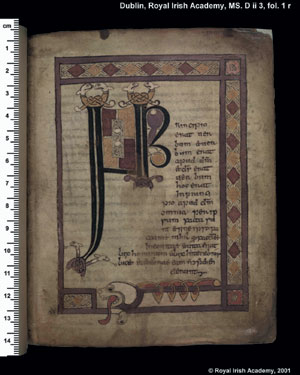| 2003 |

|
YEAR BOOK |
Dublin Institute for Advanced Studies
|
Irish Script on Screen
|

ISOS uses two 5 x 4 digital cameras, digitising at 600 dpi. The original scans, the TIFF files, averaging 130 Mb in size, are too large for convenient display on the web, and so are condensed to JPEG files of around 1.5 Mb in size. Prior to being condensed, the files are processed: headers and footers, containing identification tags and notice of copyright, are inserted using a graphics software program, Debabelizer Pro. The original scans are stored on DLT tapes, copies being stored in the Dublin Institute for Advanced Studies and in the participating library.
Complete manuscripts in Irish date from the early twelfth century to the nineteenth century. The earliest, Leabhar na hUidhre, was written at Clonmacnoise about 1100 AD, and among the stories and verse it contains is the earliest version of the great Irish saga, T�in B� Cuailnge. This manuscript is held in the library of the Royal Irish Academy and is now on display on the ISOS website.
So also is another twelfth-century manuscript, the Book of Leinster. This manuscript was written near Stradbally, Co. Laois, under the patronage of Diarmaid Mac Murchaidh. It contains verse and genealogies relevant to the kingdom of Leinster, as well as revised versions of older saga material. The manuscript is housed in the Library of Trinity College Dublin and is on display on the ISOS website. Ten leaves from the manuscript were separated from it in the early seventeenth-century, and were preserved among the Franciscan manuscripts now held at University College Dublin. These ten leaves have also been digitised by ISOS, thus enabling scholars to view what survives of the Book of Leinster in its entirety for the first time in nearly four hundred years, as the book is re-unified on the ISOS website.
To date approximately 20,000 images of Irish manuscripts have been made available for viewing, free of charge, on the ISOS website. This comprises a total of eighty manuscripts, mostly of medieval provenance. The project has proved enormously popular, both with the holding libraries who view digitisation as an important element in the conservation of their materials, and with scholars and general users world-wide to whom these vital research sources are available in this format for the first time.
Contact: Professor P�draig � Mach�in, School of Celtic Studies, Dublin Institute for Advanced Studies; E-mail: [email protected]